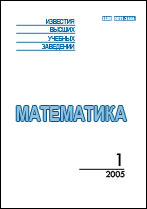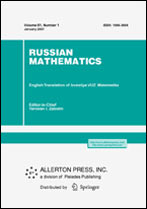|
On the spectrum of a quasidifferential boundary value problem of the second order
M. Yu. Vatolkin
Kalashnikov Izhevsk State Technical University, 7 Studencheskaya str., Izhevsk, 426069 Russia
Abstract:
The structure of the spectrum of a quasidifferential boundary value problem of the second order is studied, i.e. $(_{P}^{ 2}x)(t)=-\lambda( _{P}^{ 0}x)(t) (t\in[a,b], \lambda \in {\mathbb R})$ (the coefficients in the equation are real valued functions) with given homogeneous boundary conditions at the ends of this segment, i.e. ${ }_P^{ 0}x(a)={ }_P^{ 0}x(b)=0.$ First, we consider the auxiliary Cauchy problem with the real parameter $\beta$ in the coefficient $p_{20}(t)$ of the equation, namely, $p_{22}(t) \left(p_{11}(t)v'(t) \right)' +(p_{20}(t)+\beta)v(t)=0,$ $ v(a)=0, p_{11}(a)v'(a)=1.$ In terms of the solution to this problem, a fundamental theorem on the continuous or discrete real spectrum of the boundary value problem is formulated (see Theorem 1). Examples are given to illustrate the cases of the continuous spectrum and discrete spectrum for the boundary value problem under consideration.
Keywords:
quasiderivatives, quasidifferential equation, two-point quasidifferential boundary value problem, Cauchy problem, real parameter, sequence of solutions, sum of series, eigenvalue, eigenfunction, spectrum of boundary value problem, discrete spectrum, continuous spectrum, root of equation, Taylor series.
Received: 24.01.2022
Revised: 15.12.2022
Accepted: 21.12.2022
Citation:
M. Yu. Vatolkin, “On the spectrum of a quasidifferential boundary value problem of the second order”, Izv. Vyssh. Uchebn. Zaved. Mat., 2023, no. 1, 3–24; Russian Math. (Iz. VUZ), 67:1 (2023), 1–19
Linking options:
https://www.mathnet.ru/eng/ivm9844 https://www.mathnet.ru/eng/ivm/y2023/i1/p3
|


| Statistics & downloads: |
| Abstract page: | 213 | | Full-text PDF : | 51 | | References: | 47 | | First page: | 21 |
|





 Contact us:
Contact us: Terms of Use
Terms of Use
 Registration to the website
Registration to the website Logotypes
Logotypes







 Citation in format
Citation in format 